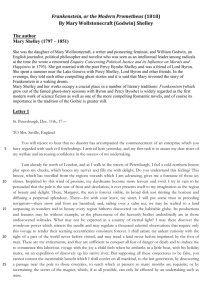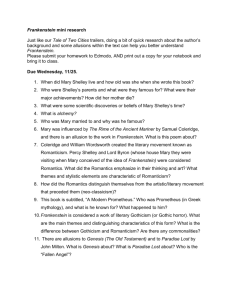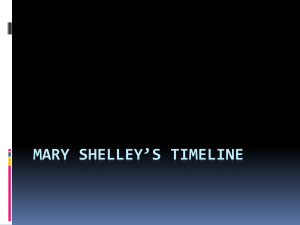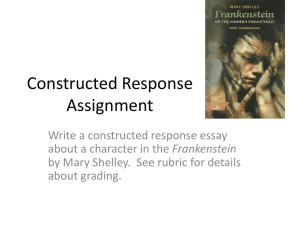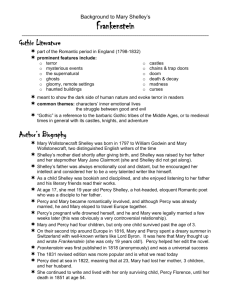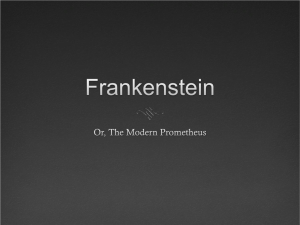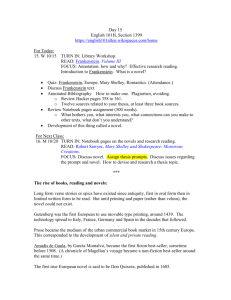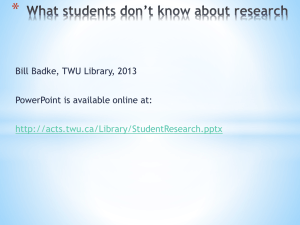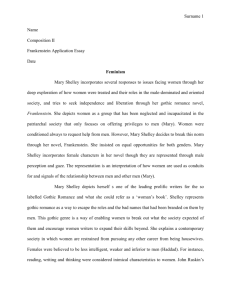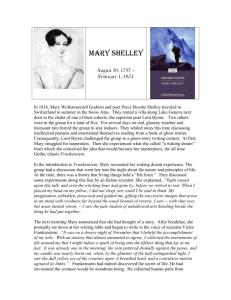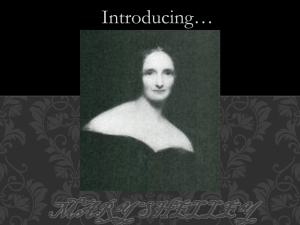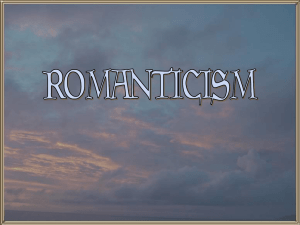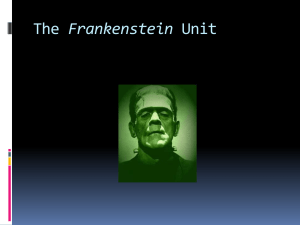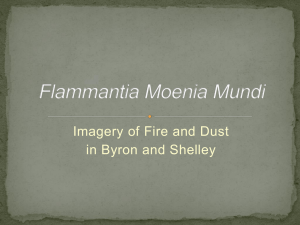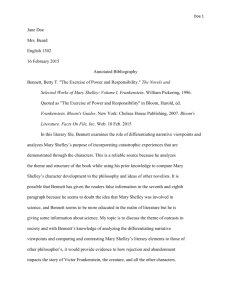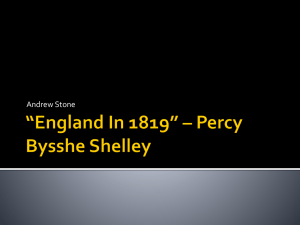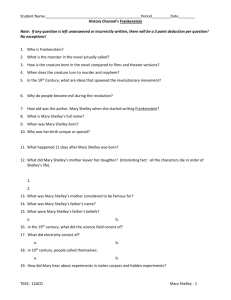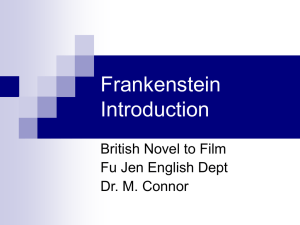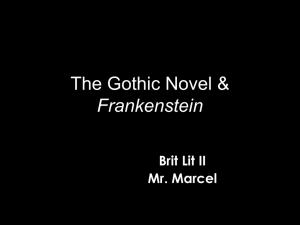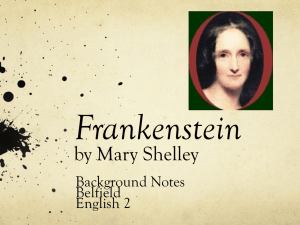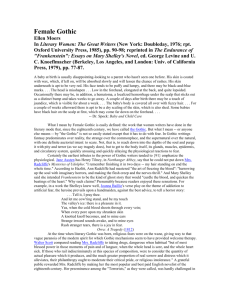Frankenstein by Mark Shelley
advertisement
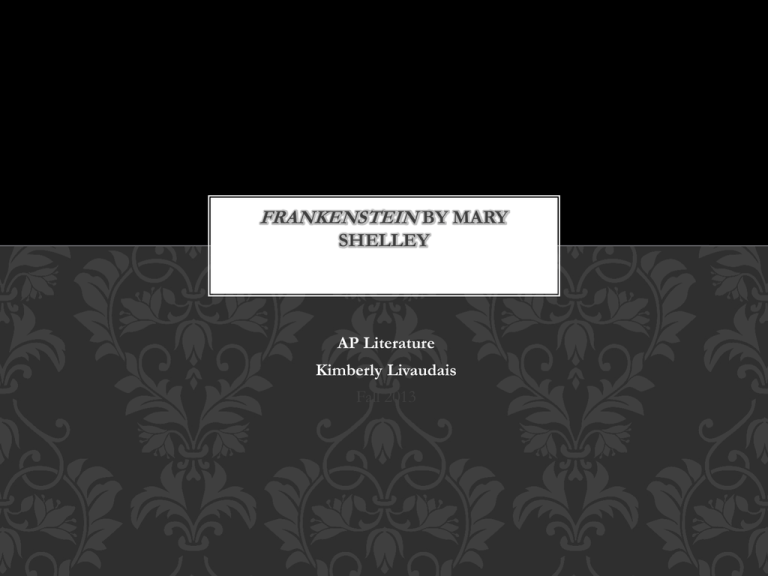
FRANKENSTEIN BY MARY SHELLEY AP Literature Kimberly Livaudais Fall 2013 LIFE AND TIMES OF MARY SHELLEY Mary Shelley was born Mary Wollstoncraft in 1797 to William Godwin and Mary Wollstoncraft both very prominent and liberal writers. Her mother had written A Vindication on the Rights of Woman, which was a very popular feminist work. Mary spent much of her teen years writing stories in Scotland until she returned to London at age 16. In her childhood, Mary Shelley educated herself amongst her father's intellectual circle, which included critic William Hazlitt, essayist Charles Lamb and poet Samuel Taylor Coleridge. Another prominent intellectual in Godwin's circle was poet Percy Bysshe Shelley LIFE AND TIMES OF MARY SHELLEY Mary met Percy Shelley in 1812, when she was fifteen. Shelley was married at the time, but the two spent the summer of 1814 traveling together. A baby girl was born prematurely to the couple in February, 1815, and died twelve days later. In her journal of March 19, 1815, Mary recorded the following dream, a possible inspiration for Frankenstein: "Dream that my little baby came to life again - that it had only been cold & that we rubbed it before the fire & it lived." A son, William, was born to the couple in January, 1816. ORIGINS OF THE NOVEL Mary Shelley was a nineteen-year-old Romantic thinker spending the summer of 1816 in Geneva in the company of her husband, Percy Bysshe Shelley, and the poet Lord Byron, when she penned one of the most well-known horror stories of all time. The writers were confined indoors for much of the stormy summer, and Byron set forth the challenge to write a horror story. As Mary Shelley pondered what her story might be, she listened to the conversations of her husband and Byron regarding the latest achievements—and limitations—of science. Could life be given to the lifeless? Where and how did life begin? ORIGINS OF THE NOVEL It was in this environment that Frankenstein: Or, The Modern Prometheus was conceived. Frankenstein is the story of an obsessed, glory-driven scientist whose unnatural creation corrupts his maker’s character and destroys the lives of those he loves most. It is a story of human loss and revenge, of guilt and debilitating remorse. It serves as a cautionary tale about unchecked ambition and progress, contrasting the powerful beauty of the natural world with an abhorrent creation of man. In the end, Frankenstein is a story of an abominable creature, its abominable creator, and their inextricable connection to one another. LIT TERMS TO KNOW Frame narrative Character types: round, flat, static, dynamic Literary allusion Symbol Epistolary Romantic Movement Gothic Literature Catalyst Tabula Rasa BILDUNGSROMAN 1. A Bildungsroman is, most generally, the story of a single individual's growth and development within the context of a defined social order. The growth process, at its roots a quest story, has been described as both "an apprenticeship to life" and a "search for meaningful existence within society." 2. To spur the hero or heroine on to their journey, some form of loss or discontent must jar them at an early stage away from the home or family setting. 3. The process of maturity is long, arduous, and gradual, consisting of repeated clashes between the protagonist's needs and desires and the views and judgments enforced by an unbending social order. 4. Eventually, the spirit and values of the social order become manifest in the protagonist, who is then accommodated into society. The novel ends with an assessment by the protagonist of himself and his new place in that society. THEMES, MOTIFS, AND SYMBOLS Themes Motifs Science vs. nature Purity of man Ego and glory Knowledge/Education Beauty and the importance of appearance Passion derived from books Hiking/walking as a source of comfort Selflessness Gothic elements THEMES, MOTIFS, AND SYMBOLS Symbols William’s locket Mont Blanc Scientific instruments Captain Walton Letters QUESTIONS EVOKED What are the consequences when the wishes of God or nature are defied? Which fate is worse—to die or to live and suffer? WORKS CITED “Frankenstein. Mary Shelley.” AP Learning Packet. Prestwick House. Pdf. 07 June 2013. “Frankenstein: Mary Wollstonecraft Shelley.” Duluth Public Library. 24 October 2005. Web. 07 June 2013. “Frankenstein, or the Modern Prometheus.” Enotes. Pdf. 07 June 2013. “The Bildungsroman Genre.” Victorian Web. 21 February 2005. Web. 07 June 2013

